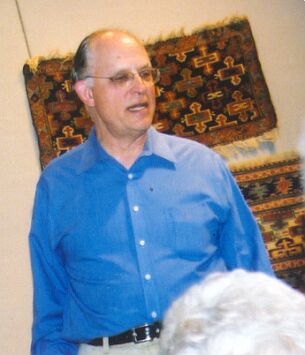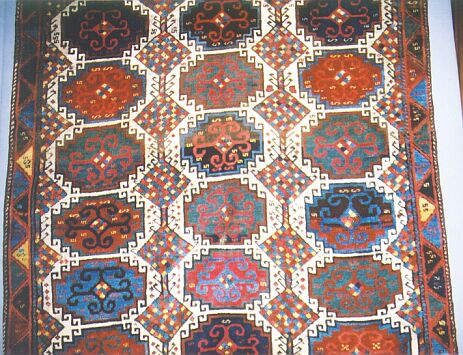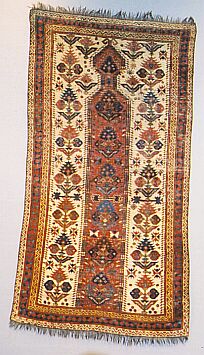
The Salon du Tapis d'Orient is a moderated discussion group in the manner of the 19th century salon devoted to oriental rugs and textiles and all aspects of their appreciation. Please include your full name and e-mail address in your posting.
A Trunk Full of My Favorite Things: A "Rug Morning" with Joe Fell
by R. John Howe
Joe Fell, was for years a high-end rug dealer in the Chicago area, known to have exquisite material.

He is now retired, but is still active in the rug world and is a member of The Textile Museum's board of directors. On September 21, 2002 he presented a "rug morning" program at the TM and I brought my camera. Once again, I am indebted to a good set of notes taken by Christine Brown, who, like me, is a regular at the rug morning programs. Joe began with a piece that he and his wife had recently donated to the TM.

He indicated that this flatwoven piece is a veritable compendium of "Balouch" design. Here's is a closer detail of it.

Mr. Fell described the long rug on the center of the board as Yurok, likely made in Eastern Anatolia.

This rug, he said, is probably an instance of the fact that many rugs were copied from other rugs. The field design of this rug, Joe said, begins in the half position on the diamonds in it.

But about halfway up, it simply begins over again in exactly this same way.

This strongly suggests that this rug was copied from one half its length. Joe said that he personally likes purple and one more reason why this rug is one of his favorites is that its colors include a very good one.

The next piece was another longish one with a colorful Memling gul design.

Joe pointed out that Memling guls are documented in the "painter" rugs as far back as the 15th century.

He said that he thought that this rug was woven in the early 19th century or even perhaps in the 18th century in eastern Anatolia. He described it as likely Yurok. Thomas Eagleton, the Kurdish expert,was in the audience. He spoke up to say that he thought it was likely to be Kurdish. Here is one more detail of this colorful piece.

The next piece was a "zili" or "verneh" weaving with a dark brown ground and dark brown warps. It was made in two pieces and sewn together.

Joe said that some had suggested that it was from eastern Turkey. John Wertime said that he felt it was most likely to be from the Caucasus.
Next, Joe brought out a quite wonderful 19th century Bidjar, with out-of-scale palmettes and arabesques.

I thought this piece one of the best of some exceptionally strong material. The impact of the large scale of the field devices is tremendous. And the nicely-detailed white-ground border frames, but does not compete with them at all. Here is a closer look.

If I had been allowed one sample to take home, this would have been it.
Mr. Fell next put up this Yomut engsi.

He said that this rug came to him in a remarkable way. A person on welfare, who picked over things people had thrown out, found this rug in a trash pile and took it to his social worker whom he knew collected rugs. The rug is in remarkable condition and the social worker offered to buy it. The person on welfare was reluctant to accept any cash, since this might disqualify him from receiving welfare, but said to the social worker that there was a chenille mat in a local store that he wanted and that he would be willing to trade this engsi for it. The social worker purchased the mat and made the trade and brought the piece to Fell. Joe said that finding antique rugs in trash was a fairly frequent thing during his early days as a dealer, and Harold Keshishian offered from the audience that there was supposedly a collection of rugs once in NYC, composed entirely of pieces that had been rescued from the trash pile. Joe responded that they were likely pretty old rugs since these seemed often to be what were thrown out. Wendel Swan said that he was once visiting a dealer to barter about a Turkmen engsi and noticed that there was an antique fragment, at the back, apparently to be thrown out in the trash that seemed to him potentially more valuable than the engsi. He said that he would pay the dealer's price for the engsi if the dealer would throw in the piece from the trash pile. The dealer said, "Sure, it's going to be thrown out in the morning, anyway." Fell cautioned that the days when antique pieces are found in the trash seem over now.
The next piece, shown below, is a Beshiri "prayer rug."

This piece seemed to me to be one of the more attractive examples of this very collectible format and design. The next piece was also a much desired design. It is an Ersari/Beshiri chuval with a mina khani field.

This chuval does not have the range of color sometimes found in these pieces, but it has an interesting elem design.
